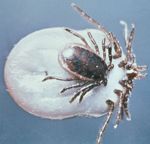<ncl style=bullet maxdepth=3 headings=bullet headstart=2
showcats=1 showarts=1>Category:Ticks</ncl>
| This article has been peer reviewed but is awaiting expert review. If you would like to help with this, please see more information about expert reviewing. |
Introduction
Ticks (Suborder: Metastigmata) Ticks are ectoparasites which live by haematophagy on the blood of mammals, birds and sometimes reptiles and amphibians. Ticks are of considerable veterinary importance, particularly in warmer climates where they can cause substantial economic losses through decreased productivity and most importantly by disease transmission. They are also important in human medicine as they cause Lyme Disease (borreliosis) and tick-borne encephalitis/meningoencephalitis.
Ticks decrease productivity by causing fleece and hide damage, preventing animals from feeding (tick worry), ascending motor paralysis and anaemia. Infestation can also lead to secondary infection from blowfly and screw worms leading to strike.
The soft ticks are only of importance in warmer climates, whereas the hard ticks cause significant problems in both warmer and temperate climates.
Tick Morphology
Life cycle
- Ticks are temporary parasites so only spend a short period of their lives on the host species
- When larvae are seeking a host they are known as seed ticks
- Both hard and soft ticks have the same life cycle
- Egg → larva → nymph → adult
- Soft ticks feed little and often and on many hosts
Hard ticks
- Classified depending on the number of host species they parasitise during their life cycle
- Take one blood meal at each life cycle stage which lasts several days
- One-host ticks
- Each stage feeds and develops on one host (the same host)
- E.g. Boophillus spp.
- Two-host ticks
- Larvae and nymphs feed on one host
- Adults feed on a second host
- E.g. Hyalomma
- Three-host ticks
- Each stage feeds and develops on a different host
- E.g. Ixodes spp.
Disease transmission
- Trans-ovarian transmission
- Infection is passed from one generation of ticks to the next through the egg
- E.g. Babesia
- Trans-stadial transmission
- Parasite or microbial organism is ingested during feeding
- Organism passed onto the next host as the tick develops (only in two and three host ticks)
- It is not passed onto the next generation through the egg
Subcategories
This category has the following 3 subcategories, out of 3 total.
Pages in category "Ticks"
The following 5 pages are in this category, out of 5 total.
